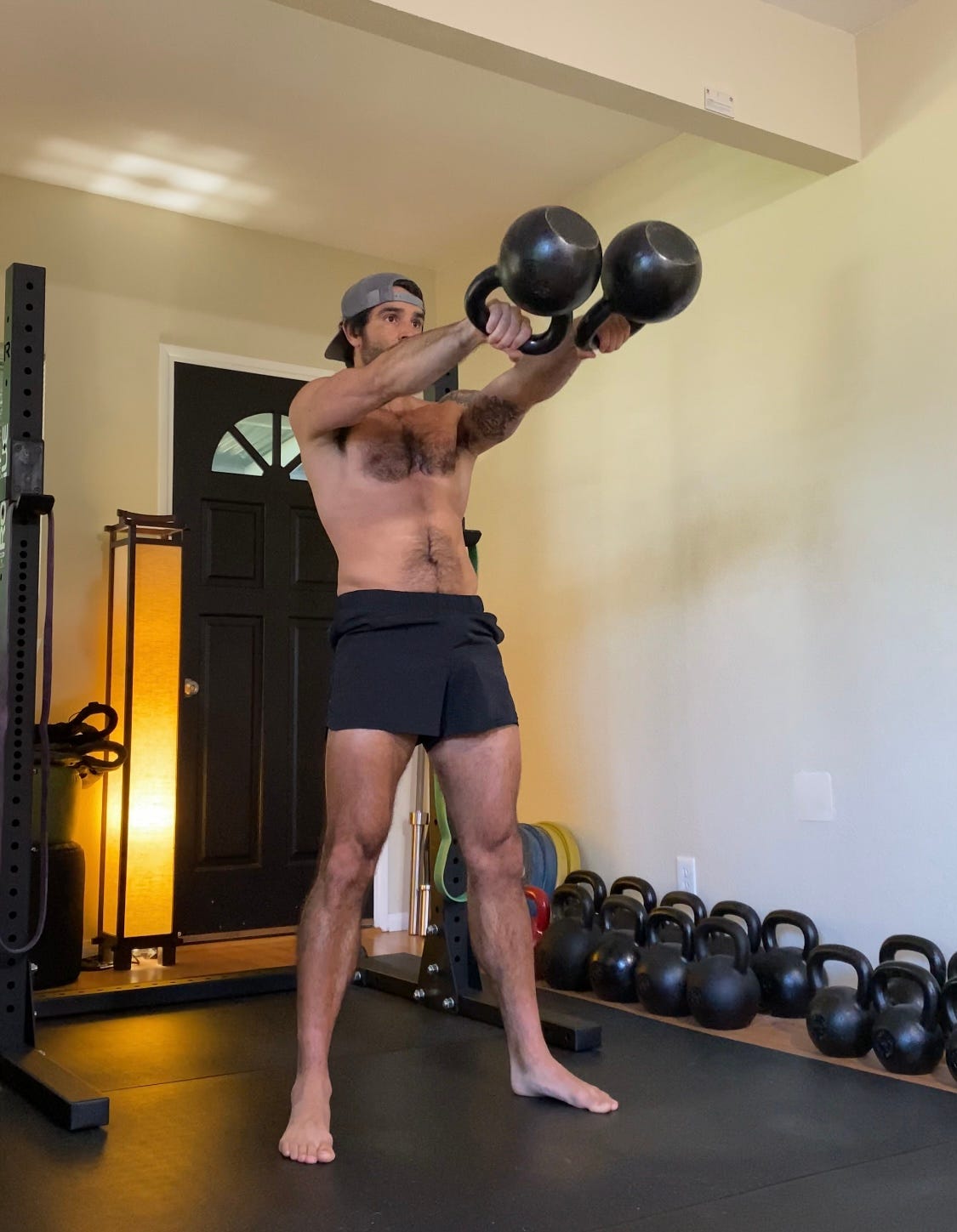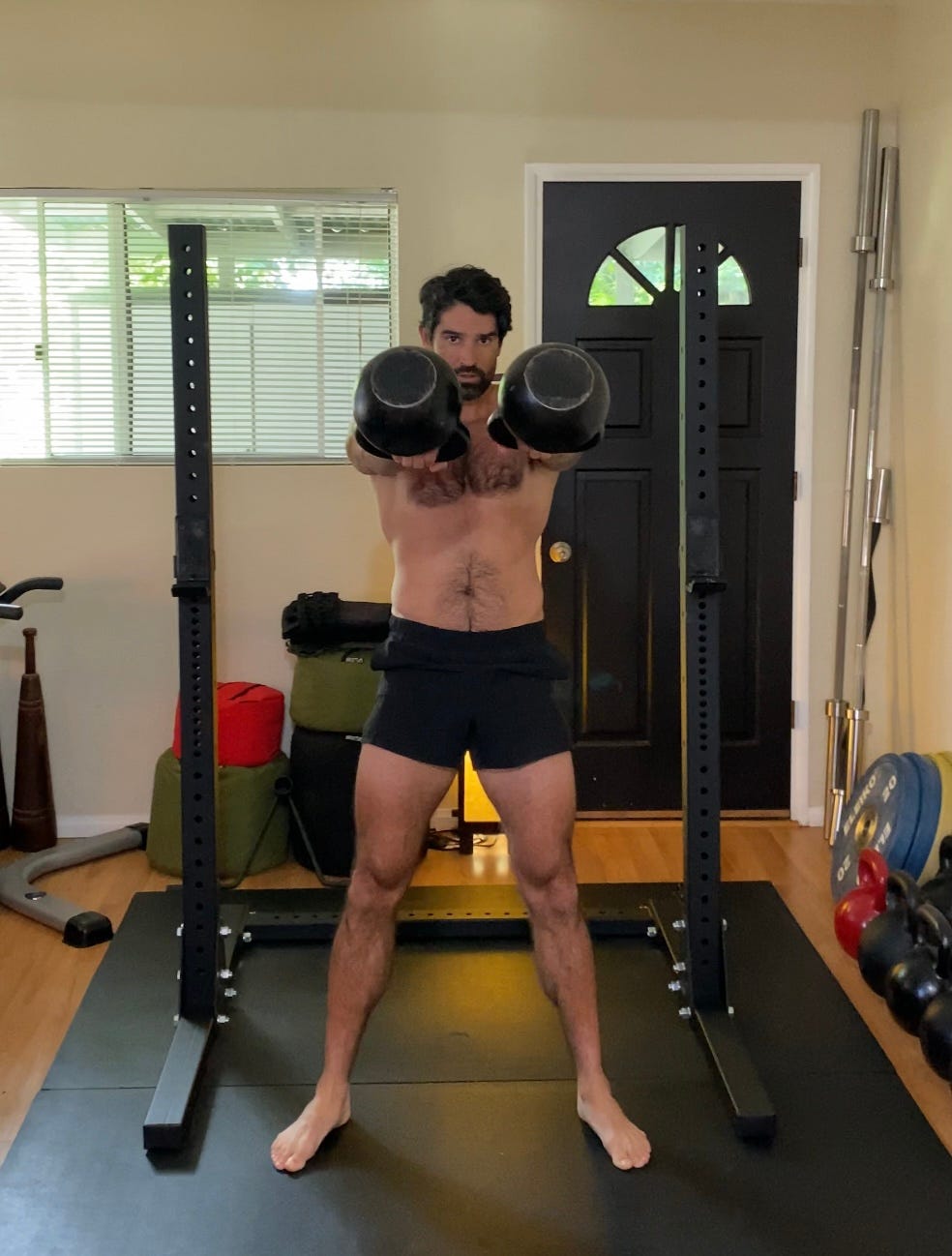The Double Kettlebell Swing (DBSW) is the ultimate iteration of Hardstyle mechanics. It is a movement that hones full-body explosiveness and builds the engine of power and power endurance. Used in combination with cleans, presses, and squats, the DBSW develops top-end ballistic capacity within MED Kettlebell Chains programming.
Perfecting the DBSW as apart of MED Kettlebell Chains Reloaded adds complexity to our base kettlebell chains; promoting advanced levels of power, strength, and conditioning. By positioning the DBSW on the tail of Chain B, we add time under tension and advanced conditioning to our ballistic chain.
MED Kettlebell Chains (MEDKC) volume and intensity parameters were carefully programmed to promote a foundation of sustainable strength. The next iteration of the program, MED Kettlebell Chains Reloaded (MEDKCR), builds on the ladders of the original, but adds a Double Kettlebell Snatch in Chain A and a Double Kettlebell Swing in Chain B
In this article, I will focus on the progressions for learning the DBSW along with how to program the DBSW into your current training program. The DBSW may be programmed as a standalone exercise, into a chain, or as apart of a complex. MEDKCR athletes will be provided with a private link in using the DBSW and DBSN in their MED programming.
Double Kettlebell Swing with 24kg bells. In order to safely swing double kettlebells, the athlete should be comfortable in matching that weight with a single bell. In this case, I am comfortable with swinging a 48kg “Beast” kettlebell and have the auxiliary practice to successfully swing two 24kg bells.
The Double Kettlebell Swing
The DBSW is remarkably similar to the Single Kettlebell Swing (SW). In a traditional SW, the athlete keeps two hands on the kettlebell and performs a bilateral hip hinge that maximizes concentric power to chest level. As the kettlebell reaches its apex, it is said to “float” momentarily before it descends into the backswing.
However, MEDKC and MEDKCR athletes should take their SW a step further by performing overspeed eccentrics on the kettlebell: Instead of allowing the kettlebell to descend with gravity, they should actively pull the kettlebell downward into the hips before subsequent reps. This creates an overspeed eccentric.
Overspeed eccentric on a 32kg kettlebell swing.
This high-speed downward force maximizes the load into the downswing and gives the athlete a potent plyometric effect. It is important to note that kettlebell overspeed eccentrics deliver many of the benefits of plyometric exercise without the associated wear and tear on the body.
An overspeed eccentric performed with double 24kg kettlebells. The athlete must use their lats to pull the kettlebells into the torso. As the arms reattach to the body, the athlete will hinge into the downswing with higher velocity. This increases the force of gravity and load on the hips. It is much safer than a traditional plyometric.
The overspeed eccentric is a necessary skill in MEDKC and MEDKCR. Not only does it promote more control and precision with each rep, but it demands higher strength and tissue capacity in each chain. The athlete must maintain a proper balance of tension and relaxation to achieve the desired vector angles during each DBSW.
SW vs. DBSW
Because both the SW and DBSW are bilateral hip hinging movements, they are remarkably similar in their execution. Both versions require the athlete to maximize their hip power and swing the bell(s) to a float at chest level.
However, the DBSW is often performed with a heavier total load than the SW. The athlete must develop strong hip extension and control of the bells in order to achieve the desired height of the float. And because the DBSW uses two kettlebells, the athlete must also execute symmetrical tension in both the left and right arms.
The kettlebells should apex at chest height during the DBSW. The athlete must engage the lats equally from side to side and ensure that the hips are driving the bells with equal force out of the downswing. If the tension from the upper and lower body is not balanced, the bells will swing unevenly.
The athlete should experiment with their grip (thumbs angled inward or thumbs pointed back) in the downswing to maintain lat tension and symmetrical arms. My preference is to point my thumbs nearly backward in the downswing. This allows the inside of my wrists to touch the highest part of my groin. This builds a repeatable and stable position for maximizing hip extension.
DBSW Technique
Mastering the DBSW is the product of explosive hip extension and full body irradiation. The athlete should aim to move the double kettlebells from the backswing (without having them touch) to the upswing and subsequent float at chest level.
Since the arms will be moving independently, the athlete should ensure that they maintain tension in the lats throughout the movement. Because athletes often end up swinging the double kettlebells at discordant heights, they should diligently practice having the hips propel the kettlebells, and not the arms.
Because of the long arc and associated work of the kettlebells during the DBSW, the athlete must use Hardstyle Power Breathing during DBSW repetitions.
In Hardstyle kettlebell training, each repetition is performed with maximal power: full tension in the body. Power breathing is performed through biomechanical matching of the breath. During the upswing, or positive portion of the DBSW, the athlete will power breath as the bells swing out of the deep hinge. This movement should sound like a powerful “tssss” or "shhhh" sound. The athlete will “float” the bells, then inhale sharply through the nose as the bells enter the downswing.
In this video, I am explosively extending my hips. I imagine driving 100% of my force into the floor to propel the kettlebells to chest height. You can see that after the kettlebells reach their float at chest height, I actively pull them back into the “upper triangle” of the legs. Notice the “shhhh” sound as the hips are extended. This is Power Breathing.
Drills
Before attempting the DBSW, there are a two main drills that I recommend:
The Double Kettlebell Hike
The Double Kettlebell Dead Stop Swing
The Double Kettlebell Swing
The Double Kettlebell Hike
Standards:
The Double Kettlebell Hike is performed with intention: relying on technique, total-body tension, and with beautiful and crisp form.
The athlete demonstrates Power Breathing during the hike: the athlete inhales as the bells are hiked, then exhales through a hiss as they return to the starting position.
The athlete hikes the double kettlebells through the upper triangle of the hips (above knees and below groin) while maintaining the athletic hip hinge position.
The athlete maintains gluteal, quadriceps, and abdominal bracing during the Double Kettlebell Hike.
Principle: The Double Kettlebell Hike teaches the athlete how to begin the Double Kettlebell Swing. By honing a powerful hike, the initial swing will have enough power to reach chest height. Failure to hike the bells with enough force causes an imbalance in the athlete’s weight with the load of the bells.
Pro Tip: The athlete's body will maintain a static position during the hike. The only movement that occurs is the athlete's arms pulling the bells into their torso. The tension in the hamstrings, glutes, and lower back should be maintained.
Practice: Perform 3 sets of 5 repetitions of the Double Kettlebell Hike
The Double Kettlebell Dead Stop Swing
Standards:
The Double Kettlebell Dead Stop Swing is performed with intention: relying on technique, total-body tension, and with beautiful and crisp form.
The athlete demonstrates Power Breathing during the Double Kettlebell Dead Stop Swing: the athlete inhales as the bells as the bells are hiked, then exhales through a hiss as they swing out of the hips.
The athlete swings the double kettlebells to chest height while maintaining gluteal, quadriceps, and abdominal bracing throughout the Double Kettlebell Dead Stop Swing.
The athlete parks the double kettlebells in the starting position in front of the feet after each swing. The goal of the drill is to create starting power from the floor to first swing.
Principle: The Double Kettlebell Dead Stop Swing utilizes the Double Kettlebell Hike as a preload to generate power for a single Double Kettlebell Swing repetition. The athlete must reverse the force produced from the hike into an explosive swing to chest height. As the bells descend into the backswing, the athlete should diligently return them to their starting position in front of the feet.
Pro Tip: The Double Kettlebell Dead Stop Swing is an important drill and exercise in its own right. Those new to swings often fail to generate enough power on their first swing. Not only does the swing not reach chest height, but fails to set up subsequent swings within their associated trajectories. If the hike is not powerful, the athlete’s balance will be discordant for the entirety of the set.
Practice: Perform 3 sets of 5 repetitions of the Double Kettlebell Dead Stop Swing
The Double Kettlebell Swing
Standards:
The Double Kettlebell Swing is performed with intention: relying on technique, total-body tension, and with beautiful and crisp form.
The athlete demonstrates Power Breathing during the Double Kettlebell Swing: the athlete inhales as the bells are hiked, then exhales through a hiss as they swing out of the hips.
The athlete swings the double kettlebells to chest height while maintaining gluteal, quadriceps, and abdominal bracing throughout the Double Kettlebell Swing.
The athlete actively pulls the kettlebells downward into the upper triangle of the hips after the double kettlebells float at chest height. This preloaded overspeed eccentric allows powerful subsequent swings. After the designated number of reps is achieved, the athlete parks the kettlebells in the starting position in front of their feet.
Principle: The Double Kettlebell Swing is the culmination of the aforementioned drills. After a powerful hike, the athlete will reverse the force produced from the hike into a powerful swing. As the bells reach their apex in a momentary float, the athlete will pull the bells dynamically back through the upper triangle of the hips (overspeed eccentric), load, then reverse the kettlebells’ momentum into a successive swing.
After the designated number of repetitions, the athlete should park the kettlebells in their starting position.
Pro Tip: The major issue I’ve seen in the Double Kettlebell Swing is having discordant heights of the kettlebells as they reach their apex. The athlete should check a few points: Are the kettlebells being driven entirely by the hips? Are the kettlebells hitting each other in the backswing? Are the lats equally tight on each side? The athlete should focus on having each arm line up with that side’s upper groin in the downswing. The bells should not touch. The athlete should focus entirely on a powerful hinge with no assistance from the arms to have each kettlebell reach chest height.
Practice: Perform 3 sets of 5 repetitions of the Double Kettlebell Swing
Timing
While the above teaching progressions will serve the majority of kettlebell athletes, some might still have issues in timing their DBSW. The major area of concern is that the athlete hinges too early after the float and before the kettlebells reach the upper triangle.
On the upswing, the athlete must think of swinging into a “standing plank” at the apex of the movement. They should cue themselves to “hold the quads, glutes, and abdominals.” In coaching athletes, I have had success in telling them to “hold a bit longer than they think they should.”
This forces the athlete to direct the kettlebells from their hips without using their arms during the swing. If the athlete is hinging early during the downswing, they should rectify this by filming their DBSW technique from the front, side, and at an oblique angle.
Watch the slow motion video of the DBSW and Overspeed Eccentrics:
The hips drive the movement. The arms simply hold onto the bells. As the bells leave their apex, they reattach to the torso. This momentum is carried into the downswing. This is the sequence that kettlebell athletes should aim for. Although it takes practice, it will allow better coordinated sequencing from other movements or if performing the DBSW for multiple reps.
Programming
In discussing DBSW programming, I want to offer two methods that my students and I have had great success with: Ladders and On The Minute (OTM) training.
Ladders
A segmented approach based on one block (a ladder) and multiple sets in that ladder (rungs). My go-to ladder scheme is 3 ladders with rungs of 3, 5, 8 written as 3 x 3, 5, 8.
Example: 3 x 3, 5, 8 = 3 ladders with 3 reps in rung 1, 5 reps in rung 2, and 8 reps in rung 3. (→ 3 blocks with one set of 3, one set of 5, and one set of 8)
Here is an example of how a DBSW ladder training would be organized:
FIRST LADDER
1. 3 reps
2. 5 reps
3. 8 reps
SECOND LADDER
4. 3 reps
5. 5 reps
6. 8 reps
THIRD LADDER
7. 3 reps
8. 5 reps
9. 8 reps
3 x 3, 5, 8 totals 9 sets = 48 total reps.
The athlete can tweak their ladders toward power and strength using 1, 2, 3 rungs. 1 + 2 + 3 = 6 reps total per ladder. The athlete will decide their total desired rep count prior to training, and adjust accordingly.
For instance, if the athlete decided to perform 18 total reps for power, they would perform 3 x 1, 2, 3 - total = 18 reps
A lower total volume in the ladder scheme would be appropriate in cases of loading the DBSW with more weight than the athlete is capable of swinging with a single bell alone.
For example, I can easily swing a 56kg kettlebell. However, swinging double 32kg kettlebells, 64kg total, is more challenging: it’s an increased load and one must balance swinging two heavy bells with a wider stance.
Fewer, but more concentrated and precise reps like in a 1, 2, 3 ladder, would be appropriate for this type of loading.
Rest Periods
The athlete should rest as long as needed during their ladder training. Most of my students find it intuitive that between reps 3 and 5, they won’t need as much rest as they would between 5 and 8 or 8 and 3.
My general recommendations are resting between 45” and 180,” but that will be determined by the current conditioning of the athlete and their desired workload.
On the Minute
Once an athlete has a firm grasp of DBSW technique, I like to use OTM (On the Minute) training for glycolytic and anaerobic conditioning. OTM denotes that the athlete should perform a designated number of reps at the top of each minute.
For instance, if the athlete decided that they would perform 5 reps for glycolytic training at the top of each minute for 10:00min, they would perform a total of 50 reps.
For instance, here is how OTM for 10:00min would look:
00:00 - 5 reps
01:00 - 5 reps
02:00 - 5 reps
03:00 - 5 reps
04:00 - 5 reps
05:00 - 5 reps
06:00 - 5 reps
07:00 - 5 reps
08:00 - 5 reps
09:00 - 5 reps
Total = 50 reps
The athlete could use progressive overload in subsequent training sessions by adding a minute or two each session. They could also keep the total OTM the same and simply add a repetition to the DBSW.
Finally, the DBSW can be used as a standalone exercise ie; 5 reps x 5 sets for practice reasons. But because the DBSW is such a powerful tool for power, power endurance, and overall conditioning, I prefer the ladder and OTM programming.
Onward
I have written this blogpost as a primer to MEDKC Reloaded. The advanced chains in MEDKCR will feature both the DBSN and DBSW. Please use these teaching tools if you are an MEDKCR student or just want to hone better kettlebell technique.
Just a reminder, MEDKCR athletes will be provided with a private link in using the DBSW and DBSN in their MED programming.
Have any questions or feedback? Make sure to let me know in the comments or on Instagram.
John Parker
July 5, 2022






Hi Vikas! I agree completely... I've pretty much done everything: high level bodyweight training, Olympic lifting, powerlifting, but kettlebells will always be my base. It hits different.
I'm working on making the program available standalone without the group coaching element.
Double KB work is the magic trick to get that hip drive endurance. I would say this was one of the biggest factor that helped me get through my snatch test. A lot of Double KB snatches !!!
Any chance your program is available as a standalone program that I can purchase. I know its available through OS website but I think it also has some personal coaching element attached to it?